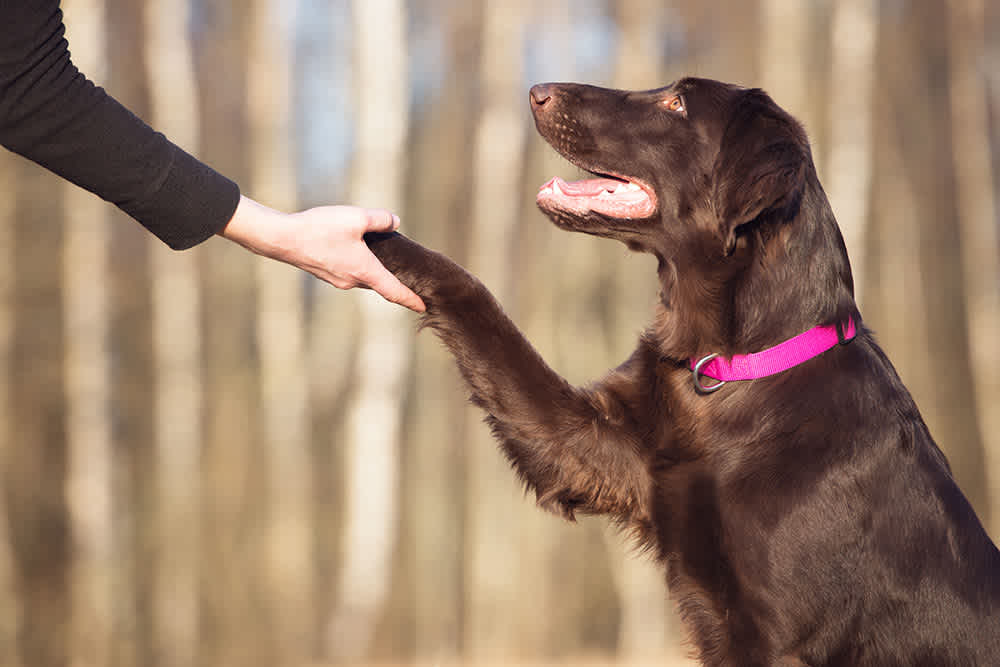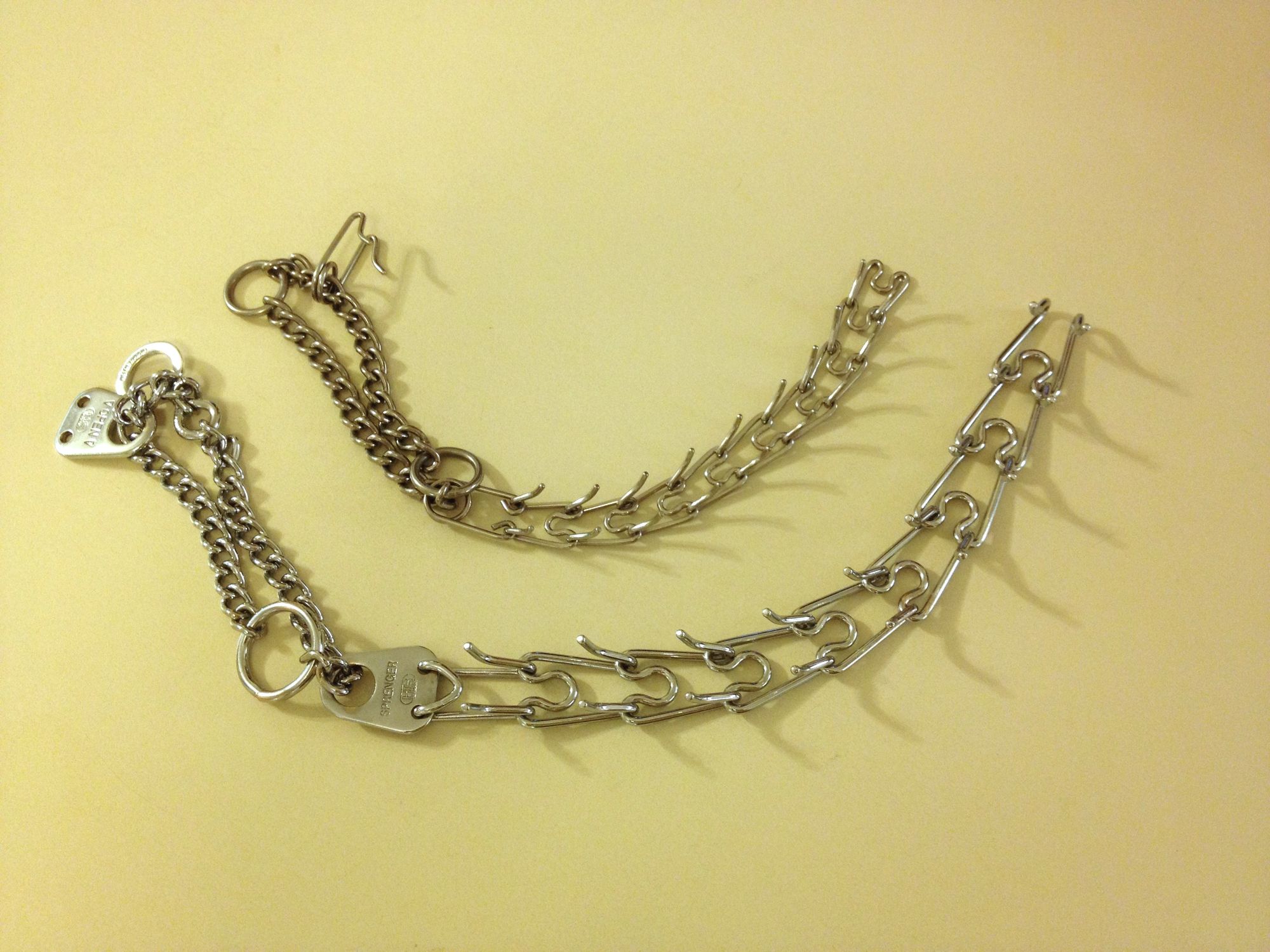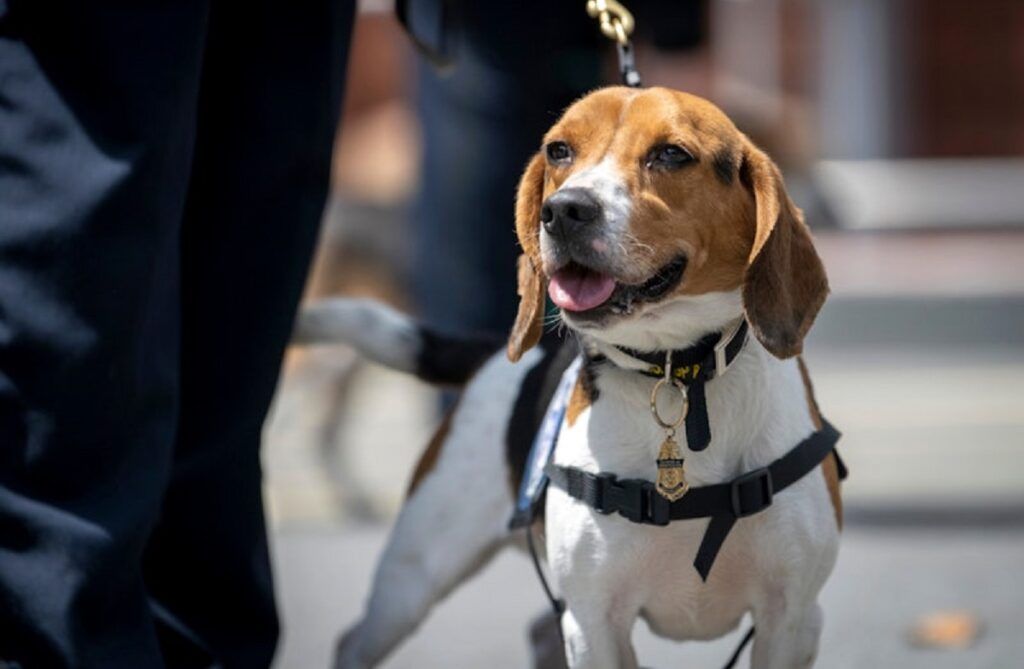Choosing the right collar for dog training is an important decision that can greatly impact the effectiveness and safety of the training process. With various types of dog collars available, it's crucial to understand their differences and suitability for different training techniques.

Here are the main types of dog collars that are commonly used for training purposes:
1. Flat Collars: These traditional collars are made from nylon or leather and are the most common choice for everyday use. They are adjustable and buckle around the dog's neck.
2. Martingale Collars: Also known as limited-slip collars, these collars have a loop design that tightens when the dog pulls on the leash. This prevents the dog from slipping out of the collar while providing more control.
3. Prong Collars: Prong collars, also called pinch collars, have metal prongs that pinch the dog's neck when tension is applied. They are controversial and should only be used under the guidance of a professional trainer.
4. Head Collars: Head collars, such as the Gentle Leader or Halti, fit over the dog's muzzle and give control by redirecting their head movements. They are often used for dogs that tend to pull on the leash.
5. Harnesses: While not technically a type of collar, harnesses distribute pressure across the chest and back instead of the neck. They are beneficial for dogs with respiratory issues or those prone to neck injuries.
When choosing a dog training collar, several factors should be taken into consideration. These include the dog's breed and size, the training goals, the dog's temperament and behavior, and the owner's comfort and handling ability. It's also important to use different types of collars for different training techniques.
Positive reinforcement training methods generally work well with flat collars or harnesses, while negative reinforcement training may require the use of tools like prong collars or head collars. However, it's always recommended to seek guidance from a professional trainer to ensure safe and effective training methods. Proper fitting and usage of a training collar is crucial for your dog's comfort and safety. Tips for fitting the collar correctly and using it appropriately should be followed to prevent any potential harm or discomfort to your furry companion.

Lastly, understanding common mistakes to avoid when using dog training collars is essential for responsible pet ownership. By being mindful of these mistakes, you can ensure that the training process is effective, safe, and built on a foundation of trust and positive reinforcement.
Types of Dog Collars
When it comes to training our furry friends, the right collar can make all the difference. In this section, we'll explore the fascinating world of dog collars and what sets them apart. From the classic flat collars to the unique design of martingale collars, we'll uncover the benefits and considerations of each type. Stay tuned for a deep dive into prong collars, head collars, and harnesses, as we unravel the diverse options available for effective dog training!
1. Flat Collars
- Flat collars, which are the most basic type of dog collar, are commonly used for everyday wear and identification purposes.
- These collars have a simple design, consisting of a strap with a buckle or snap closure, and they fit snugly around the dog's neck.
- Flat collars, typically made of nylon or leather, provide durability and comfort for the dog.
- They are available in different sizes and can be adjusted to fit the dog properly.
- Flat collars are suitable for dogs of all breeds and sizes, from small to large.
- They are commonly used for leash walking and for attaching identification tags or licenses.
- Flat collars do not provide any specialized training features, but they serve as a basic collar for everyday use.
- While flat collars are a versatile and practical option, they may not be suitable for dogs who pull excessively on the leash, as they do not provide control or prevent pulling.
- For dogs who require more control during training or have behavioral issues, other types of collars such as martingale collars or head collars may be more appropriate.
- When using a flat collar, it is important to ensure that it fits securely but not too tight around the dog's neck to prevent discomfort or injury.
Flat collars are a popular choice for everyday use and identification purposes, providing a simple and comfortable option for dogs of all sizes and breeds.
2. Martingale Collars
- Martingale collars are a type of dog collar that is designed to provide more control during training.
- They consist of a section that goes around the neck of the dog and a smaller loop that tightens when tension is applied.
- Martingale collars, also known as greyhound collars, are particularly useful for dogs with narrow heads, such as Greyhounds, as they prevent the dog from slipping out of the collar.
- These collars are often recommended for dogs that tend to pull on the leash or have a tendency to escape.
- Martingale collars, unlike prong collars or choke chains, are considered to be more humane as they do not apply direct pressure to the dog's throat.
- They provide a gentle tightening sensation that mimics the feeling of a mother dog correcting her puppies.
- When using a martingale collar, it is important to ensure that it is properly fitted and adjusted. The collar should be snug enough to prevent the dog from slipping out, but not tight enough to cause discomfort.
- Martingale collars should only be used during training sessions and not left on the dog unsupervised.
- It is always recommended to consult with a professional dog trainer or veterinarian before deciding on the best type of collar for your individual dog.
- Martingale collars can be an effective tool for training and controlling dogs while providing a safe and humane option.

3. Prong Collars
- Prong collars, also known as training collars, are commonly used in dog training to provide a quick and effective correction for dogs that pull on the leash.
- These collars consist of metal links with prongs that apply pressure to the dog's neck when tension is applied.
- When used correctly and under the guidance of a professional dog trainer, prong collars can be a valuable tool for training and managing dogs with leash-related issues.
- It's important to note that prong collars should be used with caution and in combination with positive reinforcement training methods.
- There are several considerations to keep in mind when using prong collars:
- Proper fit: The prong collar should fit snugly around the dog's neck, high behind the ears, to ensure functionality and prevent injury.
- Training technique: Positive reinforcement methods should be the focus while using prong collars to encourage desired behaviors.
- Timing and intensity of correction: Corrections with prong collars should be appropriate, firm but not harsh, and quickly released once the dog responds appropriately.
- Duration of use: Prong collars should only be used during training sessions under the supervision and removed afterward.
- Regular checks: Inspect the prong collar regularly for signs of wear or damage, replacing it if needed for safety purposes.
- It's crucial to remember that prong collars may not be suitable for every dog or training situation. Consulting with a professional trainer will help determine their appropriateness for your dog's specific needs.
4. Head Collars
When considering the use of head collars for dog training, it's important to understand their purpose, benefits, and considerations. Here is a list of key points about head collars:
- Head collars, also known as halters or gentle leaders, provide gentle control by guiding the dog's head, which allows for better control over the body.
- They are particularly useful for dogs that tend to pull on the leash, as the gentle pressure around the muzzle can discourage pulling.
- Head collars can be effective for managing reactive or aggressive dogs, as they provide more control and allow the handler to redirect the dog's attention.
- These collars should be fitted properly to ensure they are comfortable and secure. It's important to follow the manufacturer's sizing instructions.
- Introducing a head collar should be done gradually, with positive reinforcement training techniques, to help the dog associate the collar with positive experiences.
- Head collars should be used in conjunction with positive reinforcement training methods, such as reward-based training, to encourage desired behavior.
- It's vital to remember that head collars are a training tool and should not be used as a long-term solution. Once the desired behavior is learned, transitioning to a regular collar or harness is recommended.
By considering the specific needs and behaviors of your dog, along with the guidance of a professional trainer, you can determine if a head collar is the best choice for your dog's training.
True history: Head collars were first introduced in the early 1980s by Dr. Robert White, a veterinary behaviorist. He designed them as an alternative to traditional choke and prong collars, hoping to provide a more humane and effective way to control and train dogs. Over the years, head collars have gained popularity and acceptance among trainers and dog owners as a useful tool for managing leash pulling and other behavioral issues.
5. Harnesses
When it comes to choosing the right collar for dog training, harnesses can be a great option. Here are some reasons why:
- Comfort: Harnesses are known for providing more comfort to dogs compared to other types of collars. They distribute the pressure evenly across the chest and shoulders, which can be beneficial for dogs with neck or respiratory issues.
- Control: Harnesses offer better control over your dog's movements during training. They prevent pulling by allowing you to redirect their attention towards you, reducing the strain on their neck.
- Security: Harnesses provide additional security, especially for dogs that tend to slip out of their collars. With a properly fitted harness, you can have peace of mind knowing that your dog is secure and won't escape during training sessions.
- Training Support: Harnesses can be useful for dogs that require extra training support, such as those in rehabilitation or with medical conditions. They offer better stability and reduce the risk of injuries during training exercises.
- Variety: Harnesses come in various styles and designs to suit different needs. You can choose from back-clip harnesses, front-clip harnesses, or even no-pull harnesses, depending on your specific training goals and your dog's behavior.
When selecting a harness, consider factors such as the size and breed of your dog, the training goals you want to achieve, and your own comfort and handling ability. It's essential to ensure that the harness fits properly and doesn't cause any discomfort or restriction of movement for your furry friend.
Harnesses can be a versatile and effective choice for dog training, providing comfort, control, security, and support. Find the right harness for your dog's needs, and enjoy productive and safe training sessions.
Factors to Consider in Choosing a Dog Training Collar
When it comes to choosing a dog training collar, there are several factors to consider. From the breed and size of your dog to your training goals, the temperament and behavior of your furry friend, and even your own comfort and handling ability as an owner. Each sub-section in this article will dive into these factors, providing you with the essential information you need to make the best decision for your canine companion. So let's explore the world of dog training collars and find the perfect fit for your four-legged friend.
1. Dog's Breed and Size
The sub-topic "1. Dog's Breed and Size" is important to consider when choosing the right collar for dog training. Factors such as the breed and size of the dog can greatly impact the effectiveness and safety of the collar.
When it comes to the dog's breed, different breeds have different physical attributes and temperaments that should be taken into account. For example, smaller breeds may require collars that are lightweight and have a smaller width to ensure comfort and proper fit. On the other hand, larger breeds may require sturdier and wider collars to provide adequate control during training activities.
The size of the dog is also a crucial factor. It is essential to choose a collar that fits properly and is not too tight or too loose. A collar that is too tight can cause discomfort or even injury, while a collar that is too loose may not effectively control the dog during training.
To determine the appropriate collar size, it is advisable to measure the dog's neck circumference accurately. This measurement should then be used as a reference when selecting a collar. In addition to size, consider the adjustability of the collar to accommodate any potential growth or weight changes in the dog.
It is important to note that certain breeds, such as brachycephalic (short-muzzled) dogs or dogs with medical conditions, may require specific collars that accommodate their unique anatomical features or health needs. Consulting a professional trainer or veterinarian can provide valuable guidance in these situations.
When choosing the best collar for dog training, considering the dog's breed and size is crucial. Properly fitting and appropriate collars can ensure comfort, safety, and effective training for both the dog and the owner.
2. Training Goals
When considering training goals for your dog, it's important to choose the right collar that aligns with your objectives. Here are some factors to consider:
- Comfort: Choose a collar that is comfortable for your dog to wear during training sessions. Look for materials that are soft and non-restrictive.
- Control: Depending on your training goals, you may need a collar that provides effective control over your dog's movements. Consider adjustable collars that allow you to tighten or loosen the fit as needed.
- Safety: The safety of your dog should be a top priority. Avoid collars that may cause harm or discomfort, such as prong collars or choke chains.
- Training technique: Different training techniques may require different types of collars. For example, positive reinforcement training may work well with flat collars or harnesses, while negative reinforcement training may require a prong collar or a head collar.
- Breed and size: The breed and size of your dog can also influence the type of collar that is best suited for training. Larger breeds may require a harness for better control, while smaller breeds may do well with a martingale collar.
Remember, it's important to consult with a professional dog trainer to determine the best collar for your specific training goals. They can provide guidance and recommend a collar that is suitable for your dog's needs and temperament.

3. Dog's Temperament and Behavior
- When considering a dog's temperament and behavior, there are several factors to keep in mind when choosing a training collar:
- Aggression: If your dog has aggressive tendencies, it's important to choose a training collar that allows for better control and can help redirect their behavior. A martingale collar or a prong collar may be suitable options in this case.
- Fearfulness: For dogs who are fearful or anxious, using a head collar can be helpful. This type of collar gives you more control over the dog's head and can help to redirect their attention.
- Pulling: If your dog tends to pull on the leash, a harness may be a better choice. A harness distributes the pressure more evenly across their body, making it more comfortable for them and easier for you to control their movements.
- Sensitivity: Some dogs are more sensitive to the sensation of a collar or leash. In this case, using a flat collar made of soft material can be a good option.
- Size: The size of your dog is an important consideration when choosing a training collar. Make sure that the collar fits properly and is not too tight or too loose, as this can affect its effectiveness.
- It's important to remember that each dog is unique, and what works for one may not work for another. It's always best to consult with a professional dog trainer or veterinarian who can provide guidance tailored to your dog's specific temperament and behavior.
4. Owner's Comfort and Handling Ability
When considering the comfort and handling ability of the owner, there are certain factors to keep in mind:
- Size and weight: Choose a dog training collar that is appropriate for your own comfort and handling ability as the owner. A larger collar may be more difficult to handle if you have smaller hands, while a heavier collar may become cumbersome over time.
- Material: Consider the materials used in the construction of the collar. A soft and padded collar can provide extra comfort for both you as the owner and your dog. Look for materials that are durable and easy to clean.
- Adjustability: Ensure that the collar is adjustable to fit comfortably around your neck as the owner. This will allow you to find the perfect fit and avoid any discomfort or rubbing.
- Control and handling features: Look for collars that have features designed to enhance your control and handling ability as the owner. For example, a collar with a sturdy grip or grip handle can make it easier to hold onto your dog during training sessions.
To ensure a positive training experience for both you as the owner and your dog, it's important to prioritize your own comfort and handling ability when choosing a dog training collar. By considering these factors, you can find a collar that is not only effective for training purposes but also comfortable for you to use.
Using Different Types of Collars for Different Training Techniques
Discover the incredible impact of using different types of collars for various training techniques. From positive reinforcement training to negative reinforcement training, we'll unlock the power of each approach. Unleash the potential of your furry companion by understanding how these training methods can shape their behavior and enhance their learning experience. Get ready to dive into a world where the right collar can make all the difference in your dog's training journey.
1. Positive Reinforcement Training
- Positive reinforcement training is a highly effective method for training dogs.
- It involves rewarding desired behaviors to encourage their repetition.
- This type of training focuses on positive associations and rewards, rather than punishment.
- Rewards can include treats, praise, and playtime with their favorite toys.
- By consistently rewarding desired behaviors, dogs learn to associate those behaviors with positive outcomes.
A true story that exemplifies the power of positive reinforcement training is the story of Max, a rescue dog who had a history of fear-based aggression. His new owner, Sarah, wanted to help Max overcome his fears and become a well-rounded and happy dog. Instead of using harsh training methods, Sarah decided to try positive reinforcement training.
She started by rewarding Max whenever he showed calm and relaxed behavior. Whenever he approached new people or encountered unfamiliar situations without displaying aggression, he received praise and treats. Slowly, Max began to associate these positive experiences with new people and situations.
Over time, Max's fear-based aggression decreased, and he became more confident and trusting. Through positive reinforcement training, Sarah was able to cultivate a strong bond with Max and help him overcome his fears.
2. Negative Reinforcement Training
Negative reinforcement training is a controversial method of dog training that involves utilizing aversive stimuli to reduce or eliminate undesirable behaviors. While some trainers and owners may choose this approach, it is crucial to consider the potential drawbacks and ethical concerns associated with it. Here are some key factors to bear in mind when contemplating negative reinforcement training:
1. Understanding the Concept: Negative reinforcement entails eliminating or avoiding an aversive stimulus when the dog displays the desired behavior. This can involve the utilization of choke chains, prong collars, or shock collars to induce discomfort or pain when the dog misbehaves.
2. Warning Signs: Negative reinforcement training methods have the potential to cause stress, fear, and anxiety in dogs. It is essential to be mindful of any signs of distress such as cowering, trembling, or avoidance behaviors. If you observe these signs, it may be necessary to reassess your training approach.
3. Professional Guidance: It is advisable to consult with a professional dog trainer or behaviorist before resorting to negative reinforcement training. They can offer guidance and assist you in determining whether this method is suitable for your dog and their specific needs.
4. Balanced Approach: While some trainers may rely solely on negative reinforcement, it is important to incorporate positive reinforcement training methods as well. Positive reinforcement focuses on rewarding good behavior rather than punishing bad behavior, which can result in a more positive and effective training experience.
5. Individual Considerations: Dogs possess unique temperaments and personalities, meaning that what works for one dog may not work for another. It is vital to take your dog's individuality into account and choose a training method that best suits them.
I once knew a dog owner who decided to experiment with negative reinforcement training to address his dog's aggressive behavior. However, he quickly realized that this training method only exacerbated the dog's fearfulness and reactivity. After seeking professional advice, he transitioned to positive reinforcement training and witnessed significant improvements in his dog's behavior and overall well-being. This experience taught him the importance of considering the individual dog's needs and utilizing methods that promote trust and a positive learning environment.

Tips for Properly Fitting and Using a Training Collar
To ensure that you are using a training collar properly and fitting it correctly on your dog, here are some tips for properly fitting and using a training collar:
- Measure your dog's neck: Use a flexible measuring tape to measure the circumference of your dog's neck, just above the shoulders. This will give you an accurate measurement for choosing the right size of training collar.
- Choose the appropriate collar type: There are different types of training collars available, such as flat buckle collars, martingale collars, and head collars. Consider the specific needs and behavior of your dog when selecting the most suitable collar type.
- Fit the collar properly: Ensure the collar fits snugly around your dog's neck without being too tight or too loose. You should be able to fit two fingers comfortably between the collar and your dog's neck.
- Use positive reinforcement techniques: Training collars are most effective when used in conjunction with positive reinforcement training methods. Pair the use of the collar with rewards, praise, and consistent training cues to encourage desired behavior.
- Seek professional advice if needed: If you are unsure about how to properly fit or use a training collar, it is always helpful to consult a professional dog trainer or behaviorist. They can provide guidance tailored to your dog's specific needs.
I was struggling with my dog's excessive pulling during walks, so I decided to try using a training collar. After measuring his neck and selecting the appropriate collar type, I fit it on him following these tips. With consistent training and positive reinforcement, I noticed a significant improvement in his behavior. Now, our walks are much more enjoyable, and he responds well to the cues given with the collar. It was a valuable tool in our training journey, but it was essential to use it properly and in combination with positive reinforcement techniques.
Remember, using a training collar is just one aspect of training your dog. It is crucial to be patient, consistent, and to prioritize your dog's comfort and well-being throughout the process.

Common Mistakes to Avoid in Using Dog Training Collars
When using dog training collars, it's important to avoid common mistakes in order to effectively train your dog while ensuring their well-being. Here are some common mistakes to avoid in using dog training collars:
- Not choosing the right collar: It's crucial to select a collar that is appropriate for your dog's size, breed, and temperament. Using the wrong collar can cause discomfort or even harm your dog.
- Using excessive force: Pulling too hard on the leash or applying excessive pressure on the collar can be harmful to your dog's neck and throat. It's important to use gentle and consistent pressure when training.
- Improper fit: A collar that is too tight can cause discomfort and restrict your dog's movement, while a collar that is too loose may slip off or become ineffective. It's essential to ensure a proper fit for your dog's safety and comfort.
- Inconsistent use: Consistency is key when using training collars. Inconsistent use can confuse your dog and make the training process less effective. Establish clear training routines and stick to them.
- Ignoring signs of discomfort: Pay attention to your dog's behavior and body language. If your dog shows signs of discomfort or distress while wearing a training collar, it's important to address the issue and make necessary adjustments.
To ensure successful dog training, remember to choose the right collar for your dog, use gentle pressure, ensure a proper fit, be consistent in your training, and prioritize your dog's comfort. By avoiding these common mistakes, you can effectively train your dog while maintaining a positive and safe training experience.
Frequently Asked Questions
What type of collar is best for dog training?
The best type of collar for dog training depends on various factors, including the dog's size, breed, behavior, and specific training objectives.
What are the pros and cons of gentle training collars?
Gentle training collars, such as the Halti or slip collars, are effective for correcting bad behavior or teaching good behavior. They provide mild correction and are generally comfortable for the dog. However, they may not be suitable for all dogs or training needs, and proper training techniques should still be employed.
What are the pros and cons of aversive collars?
Aversive collars rely on physical discomfort or pain to correct behavior, which is not considered humane. They can lead to aggression and may have negative consequences on the overall well-being of the dog. It is recommended to use positive reinforcement training methods instead.
Which type of collar is suitable for large dogs?
For large dogs, a top-attach body harness or a head halter can be suitable options. These provide control, comfort, and can effectively manage the strong and energetic nature of larger breeds.
Are there any quick remedies for dogs that pull on the leash?
One quick remedy for dogs that tend to pull on the leash is using a front-attach body harness. This type of harness can help distribute the pulling force more evenly, making it easier to control and redirect the dog's behavior.
What are the advantages and disadvantages of neck collars for dog training?
Neck collars, such as prong collars or choke chains, can provide correction and control for certain behavior issues. However, their use can be controversial and requires proper training and caution to prevent injury or discomfort to the dog. It is important to weigh the benefits and potential risks before using neck collars for training.




